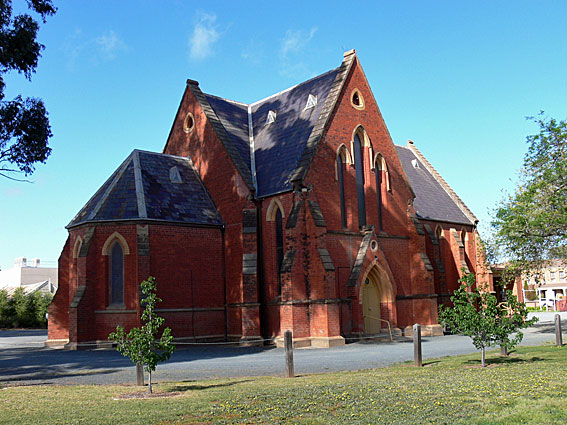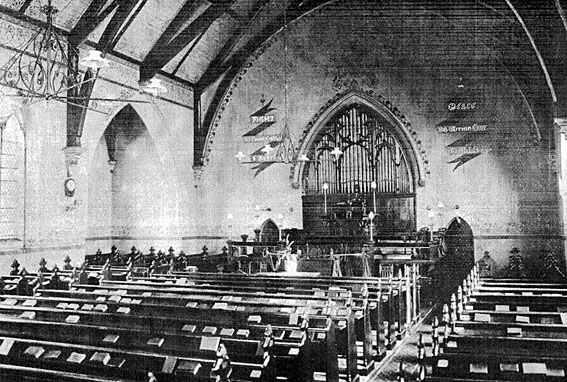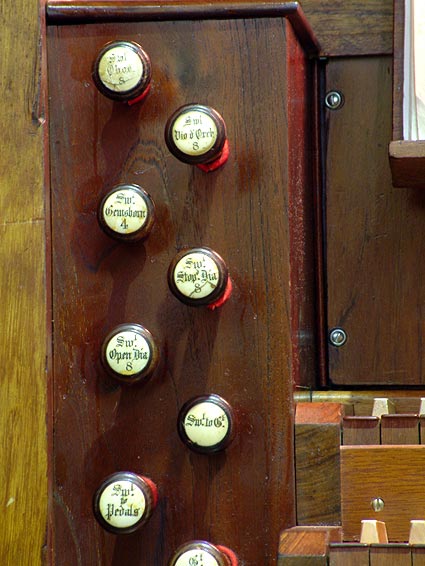The structure of the present Echuca organ (case parts, manual windchests, console, drawstops and manual action comes from the 1873 instrument built by George Fincham for St Giles' Presbyterian Church (the High Church) in Geelong; this was possibly the first pipe organ in a Presbyterian Church in Victoria. A new organ by Frederick Taylor of Hawthorn was installed at Geelong c.1919 and the old organ was removed in that year to Echuca. Taylor retained at Geelong almost all of the Fincham pipework for his otherwise new organ, including the Great Open Diapason, Stopd Diapason, Dulciana, Principal, Flute, Fifteenth; Swell Stopd Diapason, Gemshorn, Mixture II, Cornopean and Pedal Bourdon.4 For Christ Church, the only pipework that may have been used from the Fincham organ was the Great Twelfth and Swell Open Diapason; the contemporary accounts state that "the instrument for Christ Church has since had new piping" and incorporates new unplaned black metal fluework. The Viol d'orchestra "will enable the organist to give a fine imitation of the violin, as fine an imitation as can be produced by an organ."5

Christ Church, Echuca: the organ from the nave
[photograph by John Maidment (29 September 2012)]
It is clear from a photograph of the St Giles' case, probably taken in the 1880s, from an archival collection in Geelong (supplied by Alan Glover), that the cedar case at Echuca incorporates remnants from the Geelong case, particularly the colonettes and a cusped centre flat deriving from the cut-down carved sexfoil panel at the top of the very unusual screen-like Geelong case, which filled the entire archway and likely to have been designed by Nathaniel Billing, the architect of the church in Geelong. The Echuca case consists of three flats, the central flat contained within a heavily cusped and gabled arch.
The opening recital was given on 3 September 1919 by Dr A.E. Floyd, whose programme included works by Bach, Handel, Sterndale Bennett, Wesley, Dubois and Salome.6

Christ Church, Echuca: the organ
[photograph by John Maidment (29 September 2012)]
Work has been carried out at various stages by Charles Lomas and in 1982 by George Fincham & Sons Pty Ltd who revoiced all of the pipework, installed a new wind system and schwimmers, recovered the keyboards in reverse colours and remade the slider chests with slide seals and new faceboards.
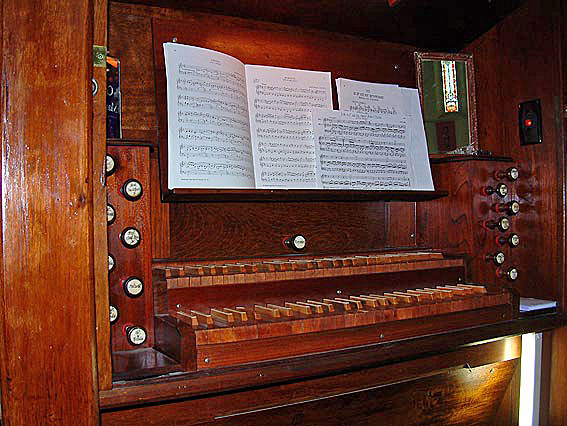
Christ Church, Echuca: the console showing reverse colour keyboards
[photograph by Pastor de Lasala (1 October 2003)]
GREAT
Open Dia Gt
Stopd Dia Gt
Dulciana Gt
Principal Gt
Flutet
Twelfth Gt
Fifteenth Gt
Swl to Gt
SWELL
Swl Open Dia
Swl Stopd Dia
Swl Vio d'Orch
Swl Gemshorn
Swl Oboe
Tremulant t
PEDAL
Bourdon t
Gt to Pedals
Swl to Pedals |
t 8ft
t 8ft
t 8ft
t 4ft
t 4ft
t 2-2/3ft
t 2ft
t
l 8ft
l 8ft
l 8ft
l 4ft
l 8ft
t
t 16ft
t
l
|
t bass in facade
t
t bass in facade
t
t
t [Fincham: spotted metal]
t
t
l [Fincham: spotted metal] grooved bass
l
l TC (Taylor)
l
l
t
t
t
l
|
Compass: 56/29
Attached drawstop console
Mechanical action to manuals and stops
Lever swell pedal
2 composition pedals
The organ was thoroughly renovated by Wakeley Pipe Organs in 2011-2012. Many of the manual and pedal trackers had been broken through unauthorized entry to the organ and have been repaired. The Pedal Bourdon pipes at the side of the organ have been raised, winded from metal conveyances, and new panels constructed beneath to match those in the main façade. The keyboards, inappropriately recovered in 1982 in timber, with new reversed colour sharps, have been replated in ivory resin with boxwood fronts and new ebony sharps fitted by P&S. All of the key and stop actions have been overhauled and a new humidification plant installed, made by Watkins & Watson, placed in the original external blowing chamber. On the Swell Organ, two inferior stops by Taylor (an Oboe and a Viol d'Orchestre) have been replaced by a Cornopean 8 and a Mixture 2 ranks, closely modelled upon those in the 1878 Fincham organ at St Augustine's Anglican Church, Inglewood. These two stops were originally present in the Echuca organ when in Geelong and the Mixture upperboards survived. To accommodate the Cornopean, the swell box was extended upwards, and the shutter front remade to incorporate a tuning flap. The façade pipes have been carefully refinished in high quality gold paint and the casework and console wax polished with the inappropriate screw holes in the latter plugged and filled with matching timber.7
The organ was reopened on Friday 28 September 2012, with rededication by Bishop Andrew Curnow and a recital by John Rivers.
The 2012 specification follows, which is almost exactly the same as the 1873 Fincham organ:
GREAT
Open Dia Gt
Stopd Dia Gt
Dulciana Gt
Principal Gt
Flutel
Twelfth Gt
Fifteenth Gt
Swl to Gt
SWELL
Swl Open Dia
Swl Stopd Dia
Swl Gemshorn
Swl Mixture
Swl Cornopean
Tremulantl
PEDAL
Pedal Bourdonl
Gt to Pedals
Swl to Pedals
|
t 8ft
t 8ft
t 8ft
t 4ft
l4ft
t 2-2/3ft
t 2ft
t
l 8
l 8
l 8
l 2 rks
l 8
l
l16
t
l
|
t bass in facade
t
t bass in facade
t
l
t [Fincham: spotted metal]
t
t
l [Fincham: spotted metal] grooved bass
l
l
l [Wakeley 2012: spotted metal] 19.22.
l [Wakeley 2012: spotted metal]
l
l
t
l
|
Compass: 56/29
Attached drawstop console
Mechanical key and stop action
2 composition pedals
Lever swell pedal8
1 Keith Cole, A History of Christ Church, Echuca (1865-1990): Faithful Witness for 125 Years. Bendigo: Keith Cole Publications, 1990
2 Notes made by John Maidment
3 E.N. Matthews, Colonial Organs and Organbuilders. Carlton: Melbourne University Press, 1969, pp. 167, 170
4 Personal communication Robert Heatley to John Maidment August 2003
5 'New Organ for Christ Church: A Description of the Instrument; Work of Erection Commences', Riverine Herald, 28 June 1919, p.2;
6 'Organ Recital', Riverine Herald, 3 September 1919, p.2
7 Notes made by John Maidment
8 Specification noted by John Maidment September 2012

Christ Church, Echuca: the organ case: detail
[photograph by John Maidment (29 September 2012)]

Christ Church, Echuca: the console
[photograph by John Maidment (29 September 2012)]

Christ Church, Echuca: Great Organ pipework
[photograph by John Maidment (29 September 2012)]
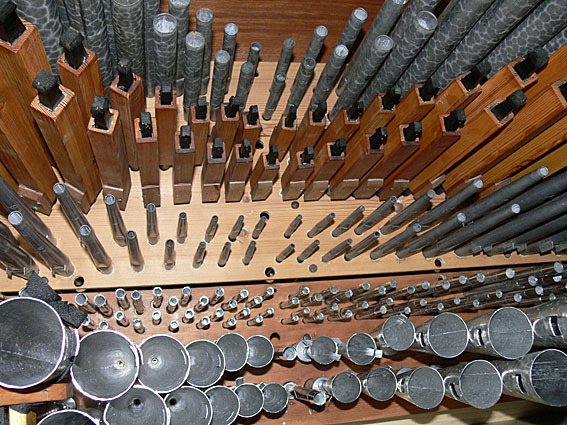
Christ Church, Echuca: Swell Organ pipework
[photograph by John Maidment (29 September 2012)]
